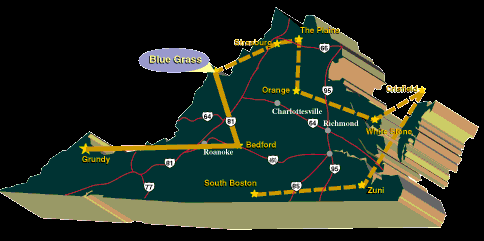 Download
in PDF Format
Download
in PDF Format
�Down Home In Blue Grass"
Pristine
and remote, this Highland community is a little piece of heaven.
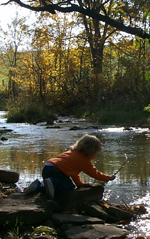
The
South Branch of the Potomac River is the perfect place to play on a
warm afternoon. |
There�s no easy way to get to the town of Blue Grass.
It sits at an altitude close to 3,000 feet in a fertile Virginia valley
surrounded by mountain ridges. Narrow roads wind lazily through the
mountains and down the valley. A tumbling stream � the South Branch of the
Potomac River � parallels one route and deepens into trout-rich pools a
mere seven miles from its source.
Entering the Blue Grass Valley from the north, one
passes through a gap overshadowed by an imposing sandstone outcrop � the
Devil�s Backbone. And it is in the shadow of the Backbone, where routes
640 and 642 intersect, and the South Branch deepens between steep hills,
that the village of Blue Grass was founded in the early 1800s.
Named after the
valley�s lush bluegrass pastures, the town was originally called
Crabbottom, a slight adjustment from an even earlier valley name �
Crabapple Bottom.
A
Place To Relax
|
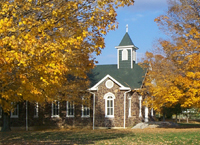
Fall
foliage frames the Blue Grass United Methodist Church at the edge of
town. |
If you�re
looking for shopping malls or neon lights, Blue Grass isn�t your town
(although there is one small red-and-blue neon �Open� sign in the
general store window). However, if you�re seeking a friendly place where
the air is clear and the fish are jumping, Blue Grass is just the ticket.
In Blue Grass you can relax while fly-fishing the
stocked waters of the South Branch, or take a slow drive through the valley
� the perfect cure for what ails you.
The valley is
renowned for its wildlife and wildflowers and is a mecca for birders, who
come to view eagles over Snowy Mountain and shrikes in the crab apple
thickets. Hiking and bike trails are found in nearby national forests and
Lake Moomaw in neighboring Bath County provides swimming and boating
recreation.
|
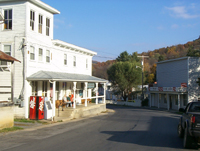
If
you're looking for shopping malls or neon lights, Blue Grass isn't
your town. |
It's
A Simple Town
Blue Grass was built to suit the industries in the
surrounding valley � farming and logging. It is one street wide and its
main street is lined with no more than 25 trim white clapboard homes,
several businesses, a church, a bank and a post office.
During the first quarter of the 20th century, Blue
Grass was a bustling town. It boasted five churches, a school, six general
merchandise stores, a soda fountain and restaurant, a hotel, two flour
mills, two barber shops, a millinery shop, a jewelry shop, two medical
doctors, two undertakers, a tinning shop, two blacksmith shops, a garage and
taxi service, and a theater.
Folks would gather in town every evening to catch up on
the news. Groups of children played kick-the-can in the street or swam in
the swimming hole behind the mill. The soda shop served up ice cream floats
and the restaurant had oyster suppers. There was a large brass band that
played at picnics and on Saturdays one could watch a movie in the theater
built over the garage.
Today, folks
watch television at home or travel over the mountains to see the latest
movie or shop at the mall, but Blue Grass still remains at the center of
valley life.
|
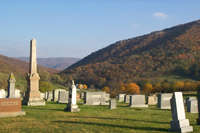
One
can look down on Blue Grass from the cemetery behind town. |
Today there�s
one general store that sells just about anything you might need. Across the
street, farm and logging machinery are repaired at Carl
Hull�s machine and welding shop, and just up the road, Wilt
Simmons runs a body shop.
A thriving and
friendly country bank, The Blue Grass Valley Bank, has been on Main Street
since its doors opened in 1915. It moved once � to a more modern
building and
now a small lending library is in its original building.
The Blue Grass Post Office sits at the edge of town, in
a brand new building, right across the street from the county�s largest
private employer, Highland Data Services.
The data-entry
firm is in the former Blue Grass school that closed its doors to students
during the county�s school consolidation in 1971. The Blue Grass Ruritan
Club bought the school building in the 1980s and it is the place where
residents gather for reunions, club meetings, wedding and baby showers, and
yard sales.
|
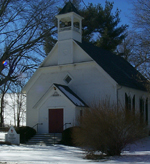
The
Good Shepherd Episcopal Church, in the nearby hamlet of New Hampden,
is one of two active churches in the area. |
There are two
active churches still near Blue Grass. The Good Shepherd Episcopal Church is
a mile down the road in the hamlet of New Hampden and The Blue Grass United
Methodist Church, constructed of stone quarried from the Devil�s Backbone
in 1923, sits between New Hampden and Blue Grass.
The
Town's Center
Linda
and Junior Kimble manage the
only store in Blue Grass � Country Convenience. You can�t miss it; it�s
the largest building in town � a three-story white building with a porch
running its length that you can almost touch if you put your hand out the
window as you drive by.
|
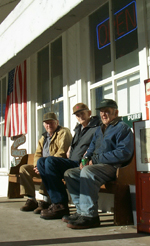
Three
of the long-time Blue Grass residents sit a spell on the porch of
Country Convenience. Pictured are: Dale Puffenbarger, whose father
ran the store in the 1940s; Randolph "Bub" Wagner; and
Charles "Tang" Rexrode. |
In good weather
the 10-foot-long wooden bench on the porch is never empty. Folks sit there
to eat their breakfast, lunch or supper; but mostly folks sit there to catch
up on what�s happening up and down the valley. If you want to find out
what makes Blue Grass tick, spend a little time sitting on the porch.
When Junior was 15 and lived in the house next door to
the store, there were four stores in town. Now, with just one store, Junior
and Linda are busy. They open the store early � breakfast sandwiches are
ready by 6 a.m. Six days a week they stay open until 9 p.m. On Sundays they�re
open from noon to five.
Blue Grass Farming
At 84, Eugene
�Gene� Rexrode still farms full-time, raising cows and calves and a
few sheep. Gene began farming a few miles south of town. Then, when his
youngest son was in high school, Gene and his wife Ava
bought his grandfather�s farm on the edge of Blue Grass.
|
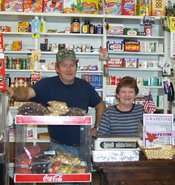
Junior
and Linda Kimble greet visitors with a smile at Country Convenience. |
Along their
driveway, behind the old high school, a few geese congregate and a blue
heron wings lazily skyward, disturbed from its foray in a trout run. The run
is fed by the large spring pouring out of the cave-peppered hillside behind
the Rexrode home, right next to the shop where Gene�s grandfather Minor
Simmons built caskets (he was one of two undertakers in Blue Grass in the
early 1900s). Another building not far from the workshop, now the sheep
shed, once housed Minor�s hearse.
Ava met Gene
far from Blue Grass during his stint in the service, returning to the valley
with him 50 years ago. At first
|
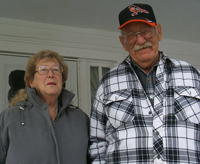
One
of Highland's oldest farmers, 84-year-old Eugene "Gene"
Rexrode hails from the Blue Grass Valley pioneer-settling stock. His
wife, Ava, is a relative newcomer, moving to the area 50 years ago
from Europe. |
she was
homesick for the city in Holland where her father ran a store.
�At father�s
store I saw more people in a day than I saw in a year here,� she says,
adding quickly, �Now I like that part of living here. And in Blue Grass
everything is so green and wonderful and you don�t have to go any farther
than your porch to see something special. One time we even saw a bear run
through the yard.�
|
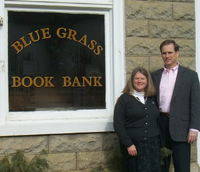
Betty
Mitchell and Brian Richardson are the force behind the Blue Grass
lending library---The Blue Grass Book Bank. |
The
Blue Grass Book Bank
Betty Mitchell
works at her computer, trying to concentrate while two three-day-old orphan
lambs nuzzle her knees.
�The joys of lambing are definitely one of the things
I like about Blue Grass,� says Betty, who moved to Blue Grass with her
husband Brian Richardson about
eight years ago. Lambs aren�t the only things that Betty has taken
under her wing in Blue Grass. When the post office moved from a circa 1915
bank building to a modern office on the edge of town, Brian and Betty
purchased the old building and turned it into a lending library � the Blue
Grass Book Bank.
The book bank is a place where kids (or adults) can go
to read, use computers, access the Internet, and receive help with their
homework. It is supported almost entirely through donations, and Brian and
Betty have come up with a rather unique way of raising some of those funds.
Each year they
cordially invite motorcyclists to come to Blue Grass and camp out at their
farm. Camp Night in Blue Grass has become a popular annual fundraiser
featuring live music, dinner and breakfast on their working sheep farm.
Motorcyclists show up in everything from classic motorcycles to sidecars and
scooters to cruise Highland�s roads by day and gather around a bonfire at
night.
A Moment of
Fame for Blue Grass
|
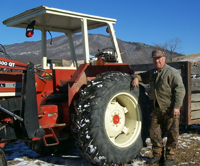
David
Kiser has moved back to his family farm, Greenstream, where he
spends his days and nights with his wife Betty tending their
livestock. |
In late
January, black-faced ewes are nursing lambs in the pasture at David
and Betty Kiser�s farm south of
town.
Blue Grass natives who moved to the Shenandoah Valley
to raise their family, the Kisers recently moved back to David�s home
place; a farm called �Greenstream� that sits on the banks of the South
Branch. The farm is named for a fictional mountain town featured in the 1921
silent film Tol�able David.
Tol�able David
may well turn out to be Blue Grass� greatest claim to fame. Its footage
was filmed in or around the town, and just about the whole town turned out
to play extras in the film. Now, long after most of the town�s extras have
passed on, there is renewed international interest in the film. It has been
remastered and silent film aficionados regard it as the finest product of
the great silent film director Henry King.
The film can be
easily found at video stores or on the Internet, or if you are in Highland
County in March during the Maple Festival you can watch it at the library in
Monterey. But if you�d rather see the real Greenstream, just drive by the
Kisers� farm on the edge of Blue Grass, where the meadows are full of
lambs kicking up their heels and the sturdy white farmhouse is once again
called home.